The Mikado Game – Part 06
|
|
Das Mikado Spiel – Teil 06
|
- In my book „From Leading to Liberty“ the horses learned in Game 30 (on page 136) how to place their feet individually and on command. We mentioned that generally a horse has no good awareness of his hind feet – they usually just automatically follow in the direction where the front ones are going. When playing those games, you will find that they fascinate your horse much more than you might have thought – nimbleness and sureness of his feet are the most important physical achievement for a flight animal!
- AND we want to break him of his reflex to flee, whenever something becomes difficult! For this too these games are very useful – they make your horse much safer to be around. Placing his feet calmly on command increases his trust in you – and being able to place them so that nothing untoward happens as a result, even in a complicated situation, greatly increases his self-confidence in his own abilities.
- So the above game 30 (the “Leg Counting Machine”) is the pre-requisite – the ground work for all the following games for sure feet, such as the Tyre Game, Walking the Plank, the See-saw Game, the Mountain Goat and the Mikado.
|
|
- In meinem Buch „From Leading to Liberty“ haben die Pferde im Spiel 30 (auf Seite 136) gelernt ihre Hufe auf Kommando einzeln zu setzen. Wir hatten erwähnt, daß ein Pferd generell keine gute Vorstellung davon hat, was seine Hinterfüße tun – die folgen normalerweise einfach in die Richtung, in die die vorderen losgelaufen sind. In diesen Spielen werden Sie merken, daß sie Ihr Pferd mehr faszinieren, als Sie vermutlich dachten – denn Gewandheit und Trittsicherheit sind einem Fluchttier die wichtigste Errungenschaft!
- UND wir wollen ihm ja auch das ständige Flüchten abgewöhnen, immer wenn etwas schwierig wird. Auch dafür sind diese Spiele sehr nützlich – sie machen Ihr Pferd verläßlich. Seine Hufe ruhig auf Kommando zu setzen, erhöht sein Vertrauen in Sie – und das zu schaffen, sogar in komplizierten Situationen, ohne daß etwas schiefgeht, das erhöht ungemein sein Selbstvertrauen in seine eignen Fähigkeiten.
- Daher ist das oben erwähnte Spiel 30 (die „Beinzählmaschine“) als Vorübung für alle Spiele der Trittsicherheit, wie das Reifenspiel, Balancieren auf Planken, die Wippe, die Bergziege und eben auch das Mikado Spiel unerläßlich.
|
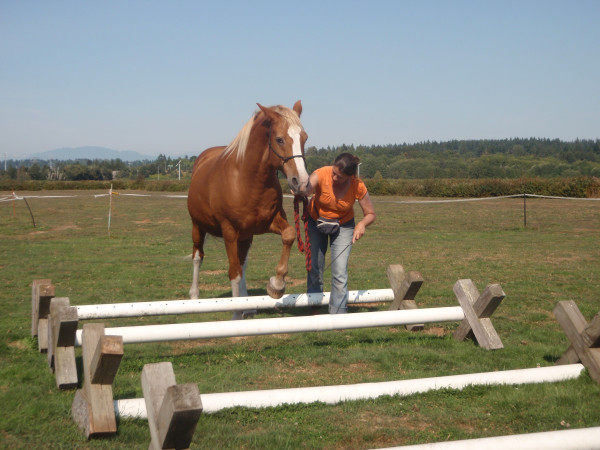 The “Leg Counting Machine” game is the necessary preparation for the Mikado game.
Das “Beinzähl” Spiel ist die nötige Vorbereitung für das Mikado Spiel.
|
- A Mikado is a Chinese game in which one must remove one piece from a hotchpotch of thrown sticks without making the other ones tumble or move. For the horse we set up a jumble of poles and encourage him to step through calmly, so the set-up does not roll apart.
|
|
- Wie im chinesischen Mikado, wo man ein Stöckchen aus dem frei geworfenen Haufen herausfischen muß, ohne daß die anderen sich bewegen, soll das Pferd hier ruhig durch einen Stangensalat steigen, ohne daß die Stangen aus der augebauten Anordnung wegrollen.
|
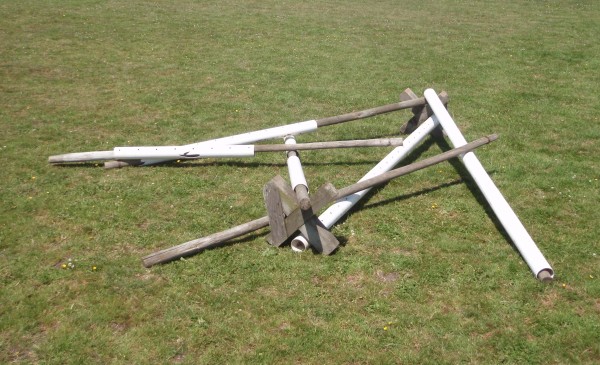 When setting up the Mikado, leave large enough spaces so the horse won’t feel trapped.
Machen Sie die Abstände zwischen den Stangen groß genug, so daß das Pferd sich nicht gefangen fühlt. |
- Remember that a horse is claustrophobic by instinct. To enter anything that looks like a trap, just because you ask him, is therefore a proof a great trust in you – and you must honor it accordingly. Remember also that your horse cannot see an obstacle, which is right under his belly, so your instructions must be very clear, in order to guarantee success. And if you don’t guarantee it – this will cause an instant loss of trust in your leadership!
|
|
- Sie erinnern sich, daß ein Pferd von Natur aus klaustrophibisch ist. Wenn es daher auf Ihren Wunsch hin in etwas einsteigt, was wie eine Falle aussieht, dann beweist das großes Vertrauen in Sie – welches Sie entsprechen honorieren müssen. Vergessen Sie auch nicht, daß das Pferd ein Hindernis direkt unter seinem Bauch nicht sehen kann, so daß Ihre Anleitungen ganz klar sein müssen, damit ein Erfolg garantiert ist. Denn wenn Sie den nicht garantieren, verliert Ihr Pferd sofort sein Vertrauen in Ihre Führung!
|
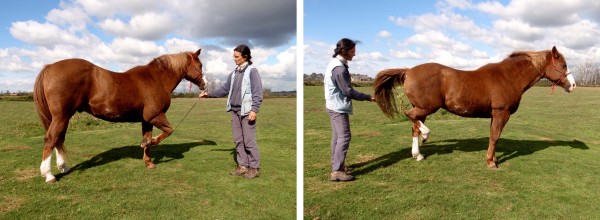 Touching Aids via whip must be well understood by the horse – see book!
Touchierhilfen müssen vom Pferd gut verstanden werden – siehe Buch!
|
- In „From Leading to Liberty“ Game 4 on page 48 you learned to give correct touching aids. [And YES, I would like you to order that book, if you don’t possess it yet, because it has so many useful lessons in it – and all illustrated with very clear drawings!]
- You must master these touching aids first, as directing your horse’s feet while in the Mikado set-up is only possible via your whip. So your horse must be used to them and understand them – otherwise he will not be able to follow your directions – the poles will roll – he will get hit on his legs by them, panic and jump out – end of game, end of trust in you, end of fun.
|
|
- Im Buch „From Leading to Liberty“ im Spiel 4 auf Seite 48 haben Sie gelernt, wie man korrekte Touchierhilfen gibt. [Und JA, ich hätte gerne, daß Sie das Buch kaufen, da es so viele nützliche Lektionen enthält – in leichtem Englisch geschrieben und mit vielen Zeichnungen erklärt!]
- Diese Touchierhilfen müsen Sie beherrschen, da Sie im Mikadospiel nur mit der Gerte die Hufe Ihres Pferdes dirigieren können. Ihr Pferd muß sie daher gewöhnt sein und sie verstehen – sonst kann es Ihre Anleitungen nicht ruhig befolgen – die Stangen werden purzeln – Pferd wird am Bein getroffen, Panik und Flucht folgen – Ende des Spiels, Schluß mit Vertrauen in den Führer und aus ist das Lernvergnügen!
|
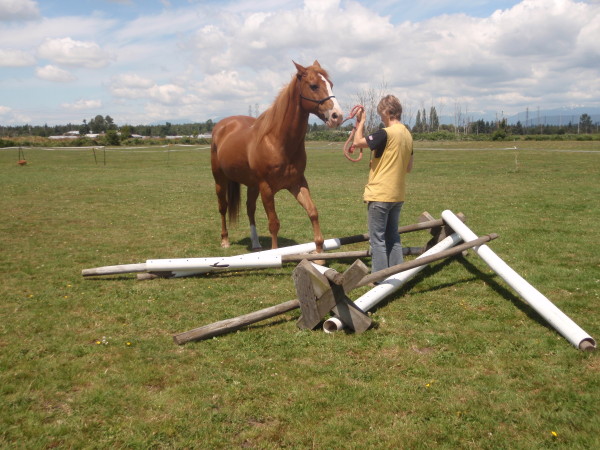 A gentle tug forward with raised hand means: “take a step!”
Ein leichtes Zupfen nach vorn bedeutet: “mach einen Schritt!” |
- You will also direct your horse by slight aids on the rope – NOT by pulling on him, of course! (That would only create counter pull and loss of trust). Lifting the rope means “come along, step!”, and sinking it means “now you can stop”.
- By gently moving the horse’s head to one side or the other, you can change his weight distribution from the right to the left foreleg. In the entire game you must pay good attention to which foot is weighted and which is “free”, as this is always the next one to move.
|
|
- Sie werden Ihr Pferd auch mit sanften Hilfen am Strick anleiten – natürlich NICHT durch ziehen! (Das erzeugt nur Gegenzug und Vertrauensverlust). Das Seil anheben bedeutet „komm mit, mach einen Schritt“ und es absenken heißt „geschafft, jetzt kannst du anhalten“.
- Indem man sanft den Kopf des Pferdes nach der einen oder anderen Seite führt, kann man seine Gewichtsverteilung beeinflussen. Durch das ganze Spiel hindurch muß man scharf beobachten, welcher Fuß gerade belastet wird und welcher als Spielbein „frei“ ist, da der immer als nächster dran kommt.
|
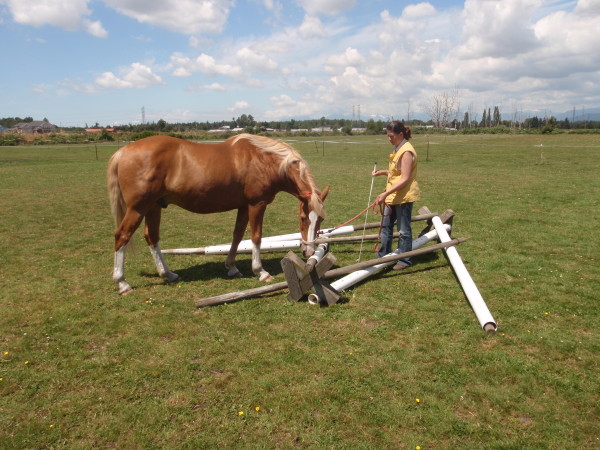 Give the horse the opportunity to inspect the obstacle.
Das Pferd muß Gelegenheit haben, das Hindernis zu erforschen. |
- First we let the horse inspect our contraption – King shows very questioning ears here! “My Goodness – he says – WHAT next!!” [See “questioning ears” in series “Understanding your Horse”, Blog 08]. Gill’s whip is in neutral position and the rope is lose.
- The aid sequence for stepping through will now be: lift rope hand to indicate that you’ll get going. Give touching aid on the foot which wants to go next – if you can’t see which one that would be, gently turn his head one way (say right – he’ll put his weight to the right) and touch the foot on the other side (left). Gently tug him forward on the rope (don’t pull!) as encouragement. Reassure with voice. Keep “touching up” the foot until it has cleared the pole. Then sink rope hand and rest whip on cannon bone. Stop and praise – feed. Continue with the next foot.
|
|
- Zuerst darf das Pferd wie immer sich die Chose anschauen – King zeigt hier sehr fragende Ohren! „Mein liebes Bißchen – sagt er –was ist den DAS schon wieder!“ [„fragende Ohren“ siehe Blog 08 von “Ihr Pferd verstehen“]. Gills Gerte ist auf neutral gestellt und das Seil ist lose.
- Die Abfolge der Hilfen zum Durchschreiten ist nun: Seil anheben als Zeichen, daß es los geht. Touchierhilfe am Fuß der unbelastet ist – wenn Sie das nicht erkennen können, führen Sie den Kopf leicht zu einer Seite (sagen wir mal rechts – dann verlagert es sein Gewicht nach rechts), touchieren Sie die andere Seite (links) zum Anheben. Zupfen Sie zur Anregung am Seil etwas vorwärts (nicht ziehen!), ermuntern Sie mit Stimme. Touchieren Sie den angehobenen Fuß weiter bis er die Stange überquert hat. Dann senken Sie die Seilhand ab und legen die Gerte am Röhrbein an. Anhalten, loben – füttern. Dann der nächste Fuß.
|
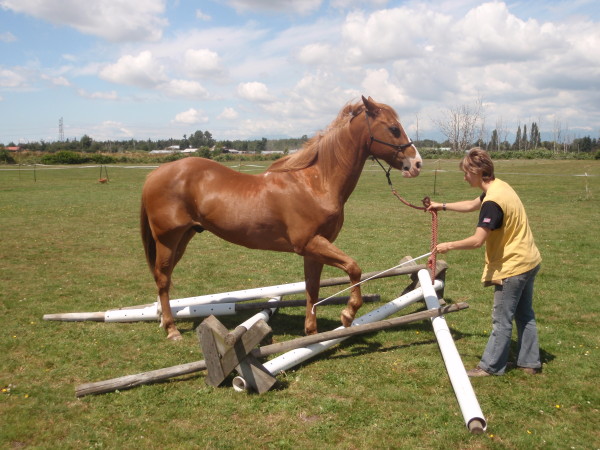 The touching aid directs the step, the rope hand controls the forward motion.
Das Peitschenzeichen dirigiert den Schritt, während die Seilhand die Bewegung nach vorn kontrolliert.
|
- Here you see Beau already in the Mikado jumble. Terri gives a touching aid on the foreleg to make him lift it high enough to clear the next pole. Her outstretched rope-hand stops the forward motion. The horse’s ears are concentrated backward into his own body – he is thinking along!
|
|
- Hier sieht man Beau schon mitten im Stangensalat. Terri gibt am Vorderbein die Touchierhilfe, so daß er den Fuß hoch genug hebt, um ohne Berührung über die nächste Stange zu kommen. Die Ohren des Pferdes sind nach hinten zum eignen Körper konzentriert – er denkt mit!
|
 The resting whip tells the horse to stop.
Die angelehnte Gerte zeigt dem Pferd, daß es stoppen kann.
|
- The foot has cleared the pole and landed safely. Terri rests the whip against his cannon bone – “leave it there, rest a moment”. (Once the horse has stopped calmly, this would be a good time to give him a treat). Then you would raise the rope hand again to indicate that you want him to move on, you would give a gentle touching aid on the next foot to move, which would be his left hind in this case (the front staying parked).
|
|
- Der Huf ist drüben und gut gelandet. Terri läßt die Gerte am Röhrbein ruhen – „laß einen Moment stehen, so ist gut“. (Wenn das Pferd ruhig angehalten hat, ist das ein guter Zeitpunkt, um ein Leckerli zu füttern). Dann heben Sie die Seilhand wieder an als Zeichen, daß es weiter geht, eine sanfte Touchierhilfe am nächsten Bein das treten soll, was in diesem Fall sein linkes Hinterbein wäre (während die Vorderbeine geparkt bleiben).
|
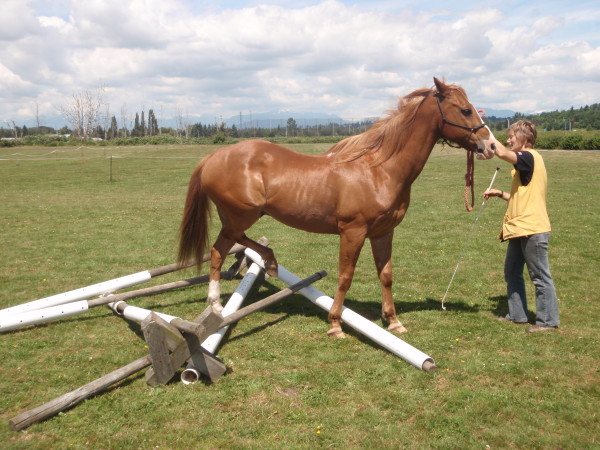 Beau is waiting for instructions from Terri, as he cannot see the pole under his belly.
Beau wartet auf Anweisung von Terri, da er die Stange under seinem Bauch nicht sehen kann.
|
- Beau is almost through! You can clearly see that he is very calm throughout. He lifts his hind leg, and as he can’t see the pole under his belly, he waits for directions from Terri – once his foot is over far enough, she will sink her rope hand and he will set his foot down. Two more feet to go and mission accomplished! Well done!
Have fun practising !!
|
|
- Beau ist fast durch! Man kann klar erkennen, daß er die ganze Zeit ruhig und konzentriert ist. Er hebt sein Hinterbein, und da er unter seinem Bauch die Stange nicht sehen kann, wartet er auf Anleitung von Terri – wenn sein Fuß weit genug herüber ist, wird sie ihre Seilhand absenken und er wird den Huf absetzen. Noch zwei Füße und er hat es geschafft! Prima Arbeit!
Viel Spaß beim Üben!!
|









